Interior surface options for health care facilities
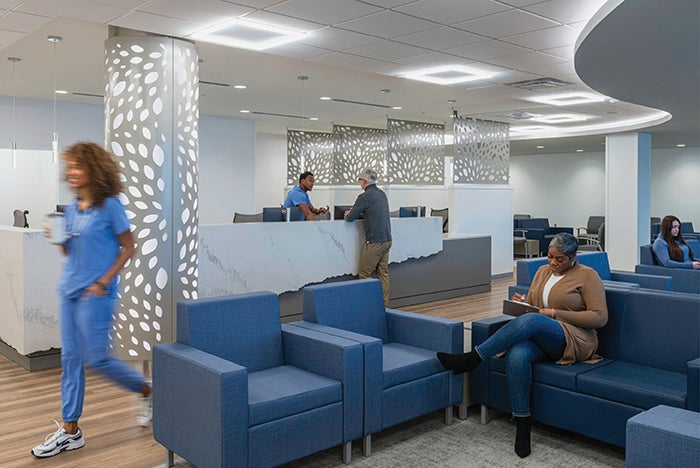
Image courtesy of Bradley Company
As the health care landscape evolves, the emphasis on selecting the right interior finishes has shifted to the forefront of design. While flooring materials receive the most attention, the latest interior surfaces for walls, countertops and ceilings embody many of the same goals, such as innovative aesthetics, cleanability, durability and sustainability.
Positive experiences
Health care design is all about creating healing environments that positively impact patient experiences, says Linda Gutierrez, senior sales and marketing manager at Móz Designs Inc., Bay Area, Calif. “Current trends include using warmer color palettes and customized branding to create a hospitality-oriented atmosphere. Digitally printed, nature-inspired patterns also can enhance the patient experience by including artwork.”
Biophilic design also is a big trend in interior surfaces. “Evidence-based design shows that exposure to the natural environment and biophilic principles can facilitate treatment by alleviating patient anxiety,” says Chris Kephalas, walls product manager at Altro USA, Wilmington, Mass. “Using images from settings such as parks, woods and coastlines to visualize familiar scenes and natural-looking materials can help convey a sense of calm.”
Cleanliness and hygiene also are key considerations, which often gravitate toward seamless, nonporous surfaces that eliminate the potential for bacteria and mold to take root, are easy to clean and suitable for use with disinfectants. “Keeping surfaces clean is critical to reducing the risk of health care-associated infections lurking on high-touch surfaces,” says Maggie Ellis, Corian design marketing leader at DuPont, Wilmington, Del.
There also is a trend toward sustainable materials. “There is a push to use post-consumer recycled content in interior products, striving for carbon-neutrality and overall material health,” says Amy Sweeting, product manager at Construction Specialties, Lebanon, N.J.
Durability is another major focus. “Hospital facilities managers want textiles that look good, offer comfort and are easy to maintain despite wear and tear,” says Sara Hall, senior textile designer at Carnegie, Rockville Centre, N.Y. “Choosing fabrics that withstand frequent use and maintain their aesthetic appeal contributes to a safe, welcoming and comfortable environment for patients and staff.”
Interior surface manufacturers continue to experiment with new materials and designs in their quest to improve infection control, durability and sustainability.
For example, Temple, Texas-based Wilsonart Engineered Surfaces conducts ongoing research and development to address issues specific to health care settings. “We experiment with new composite materials and surface treatments to enhance durability,” says Tammy Weadock, senior manager for corporate brand and communications. “This includes developing scratch-, impact- and stain-resistant surfaces that can withstand heavy use without deteriorating.”
Likewise, as an alternative to traditional materials, metal interior surfaces deliver an aesthetically pleasing product that offers durability and cleanliness in high-traffic medical spaces. “As an easy-to-clean solution, decorative metal surfacing can provide a sense of intimacy for patients while connecting to organic design,” says Gutierrez.
Recent introductions
Among recent introductions to health care facilities, Wilsonart Engineered Surfaces offers Wilsonart solid surface. It has seamless, nonporous attributes and a waterproof design that eliminates the growth of odor-causing mold and mildew. The material is relatively soft and warm to the touch, making it comfort-promoting in a treatment environment. The company recently introduced six solid surface designs that blur the lines between engineered and natural materials, according to Weadock. “These designs provide the look of authentic marble, concrete and stone, bringing the beauty of nature into health care settings,” she says.
Additionally, Wilsonart Engineered Surfaces recently introduced a variety of designs across its high-pressure laminate (HPL) and solid surface collections. “HPL offers long-term value with superior stain-, wear-, impact- and scratch-resistance when compared to traditional veneers, vinyl and wood,” says Weadock.
Durasein, Rosedale, Md., also offers solid surface materials for hospitals. “For countertops especially, our solid surface materials are durable, and their thermoforming capabilities and nonporous surfaces make them the optimal choice for applications within such environments,” says Pam Dervarics, national specifications manager. “Not only do they provide a safe solution, but they also meet the diverse needs of health care settings.”
The Lively Collection from Durasein solid surface offers an affordable and durable alternative to premium stone finishes, such as marble and limestone. Dervarics adds, “A composite of naturally derived alumina trihydrate and acrylic resin, these surfaces are antibacterial, nonporous, and impact-, scratch- and fire-resistant, yet are nontoxic, recyclable and malleable enough to be formed into custom shapes.”
Altro USA offers Altro Whiterock PopArt and Altro Whiterock wall designs that meet stringent health care guidelines while creating warm, welcoming settings that can help facilitate treatment, according to Kephalas. “The Whiterock PopArt digitally printed wall panels allow users to reproduce custom images and artwork onto Whiterock wall panels to create durable, vibrant design options for a variety of applications,” he says.
Altro’s digitally printed interior surfaces come with a variety of preselected standard imagery that can easily adapt to a facility’s specific needs. “From scenic landscapes and inspirational architecture to intricate geometric patterns, we have multiple looks that can help create calm, soothing settings for patients,” adds Kephalas. “The use of realistic artwork has been proven to reduce patient anxiety and agitation, with biophilic elements in patient rooms becoming more common.”
Móz Designs offers backlit solutions and laser-cut patterns among its metal wall covering and column solutions. “Delivering more than aesthetics, they create a welcoming focal point for patients without compromising durability and cleanliness in high-traffic medical spaces. If used effectively, illuminated designs for wall and column solutions can enhance the patient experience and play a key role in healing,” Gutierrez adds.
Recently Móz Designs introduced six colorways to its Patinas Collection, which is designed to capture the spirit of America’s national parks and the timeless allure of weathered steel. “The new colorways capture nature’s raw beauty and elegance. Available in hues of blue steel, vibrant corten, muted green, aged concrete and rubbed bronze, the new Patinas offer designers an aesthetic that typically takes years of combating the elements to achieve,” says Gutierrez.
Construction Specialties has introduced Acrovyn woodgrains, brushed metals and Strata wall coverings that feature up to 50% post-consumer recycled content. “Each of the new patterns features a complementing microtexture to enhance its appearance and create a feeling of authenticity while maintaining cleanability and durability,” Sweeting says.
Construction Specialties recently unveiled Acrovyn by Design Metallics, a durable wall covering solution that brings light reflectance into a space. “We selected a range of color options to fit into any color scheme, from neutrals to jewel tones,” Sweeting adds. “The benefits are durability and cleanability without sacrificing a high-end aesthetic. They are easier to maintain than real metal.”
Among new textile offerings, the Go-To Collection from Carnegie addresses increasing demand for transparent, responsible material choices as hospitals strive to achieve sustainability. “The Go-To Collection comprises the refreshed biobased Xorel Strie for wall coverings and wrapped panels,” Hall says. “Strie also can be specified on ceilings with Xorel Artform. The Strie Collection is 100% Xorel, with 85% bio-based Xorel derived from renewable sugarcane plants. This ensures a reduced carbon footprint over fossil fuel-based alternatives.”
DuPont offers the Corian solid surface portfolio, which features a wide range of aesthetics, all hygienic, nonporous and virtually seamless, according to Ellis. “Corian solid surface helps keep germs and viruses from hiding in cracks and crevices — making it easy to clean and disinfect. Its durability supports regular cleaning and makes it ideal for high-touch surfaces,” she says. DuPont recently added 12 colors to the portfolio, all inspired by Nature’s Canvas, many of which contain recycled content.
Corian solid surface is now offered in wide-sheet sizes, which includes 36.6-, 48-, 54- and 60-inch widths. Traditionally, Corian sheets are 30 inches wide, so the additional width helps optimize the fabrication process for faster installation in applications that previously required joining multiple sheet seams.
“Since hospital wall cladding often covers large surface areas, Corian wide sheet is a great fit, and it is National Fire Protection Association NFPA 101®, Life Safety Code®, Class A fire-rated,” Ellis says. “Corian solid surface in wide-sheet dimensions comes in a variety of standard and private collection colors.”
Casey Ball, global market director for Cleveland-based Sherwin-Williams high-performance flooring and wall systems, says fiber-reinforced epoxy resin systems are a common choice for a protective barrier against contaminants on walls and ceilings because of their easy application and durability. “For example, Resuwall Aqua FR from Sherwin-Williams combines the toughness of a fiber-reinforced epoxy with ease of application using a brush, roller or spray,” he says. “It also features resistance to ultraviolet light, which is atypical of traditional epoxy-based systems.”
Offering similar benefits, Resuwall DecoFlake from Sherwin-Williams gives health care facilities a decorative option for beautifying walls. “The system consists of water-based epoxy resins and small multi-color flakes,” Ball says. “It can be applied to drywall, block and ceramic tile or over existing painted surfaces. The slight texture provided by the small flakes disguises imperfections found in distressed wall surfaces.”
Armstrong World Industries, Lancaster, Pa., provides sustainable, cleanable ceiling and wall solutions that are designed with patient comfort and privacy in mind, according to Glenn Warwood, marketing manager. “Health Zone AirAssure ceilings have factory-gasketed edges to reduce air leakage through the ceiling plane to direct airflow more effectively and improve indoor air quality,” he says. “The panels contribute to indoor environmental quality (IEQ), patient comfort, noise control, acoustic privacy, infection prevention and sustainability.”
The newest Armstrong ceiling solution, Templok energy-saving ceilings, combines strong acoustical performance and increased thermal comfort to improve IEQ for patients and staff. Warwood adds, “Templok ceilings can save up to 15% of energy by using phase-change material to passively cool and regulate indoor temperatures — reducing heating, ventilating and air conditioning use and associated carbon emissions.”
Looking ahead
Sweeting says manufacturers will continue to push the envelope in creating products that are easy to install and easy to repair, likely due to labor shortages. “Modularity is a huge trend to help in converting a space quickly and efficiently with minimum downtime,” she says.
A continued emphasis on sustainability also will be a key focus moving forward, Kephalas predicts, noting, “Altro recently launched a recycling/take-back program — Altro Smart Collect — in North America, which focuses on recycling off-cuts of our vinyl flooring. We are now investigating ways to bring Altro’s U.K.-based wall recycling program — Recowallover — to North America as well.”
Finally, translucent materials will offer soft lighting and wayfinding to create subtle, more natural illumination, Ellis says. “Also, decorative wall panels or built-in furnishings may have controlled lighting to mimic the time of day and help with circadian rhythms,” she says.
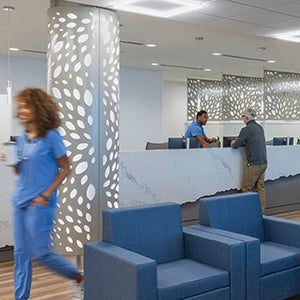
MARVELOUS METAL
Backlit metal architecture prioritizes patient wellness at Northside Gwinnett Cardio Group. Móz Designs Inc.
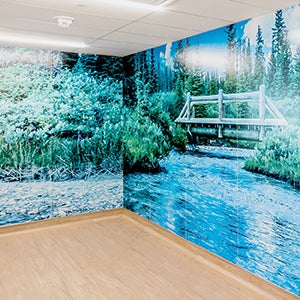
PICTURE PERFECT
Whiterock PopArt digitally printed wall panels allow hospitals to reproduce custom images and artwork. Altro USA

BONDED FOR LIFE
Resinous wall systems bond tightly and chemically to every part of a surface, offering easy cleanability and durability. Sherwin-Williams
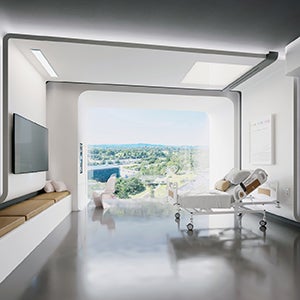
STRONG PERFORMANCE
These solid surface materials are durable and feature thermoforming capabilities and nonporous surfaces. Durasein

TOUGH STUFF
Wilsonart HPL offers stain-, wear-, impact- and scratch-resistance in health care environments. Wilsonart Engineered Surfaces

FABULOUS FABRIC
Strie bio-based, high-performance textile is available in a collection of soothing, ethereal hues. Carnegie
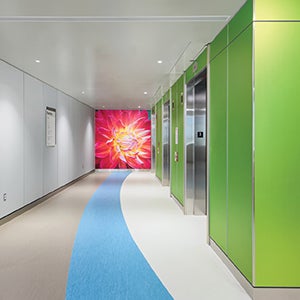
REFLECTED GLORY
The Acrovyn by Design Metallics collection illuminates a space by adding light reflection and color movement to walls. Construction Specialties

SOUND SOLUTION
Calla Shapes for DesignFlex ceilings provide sound blocking and sound absorption in one panel for acoustic performance. Armstrong World Industries

VERY VERSATILE
Corian solid surface Artista Mist and solid surface Bleached Nuwood feature a range of aesthetics. DuPont
Neal Lorenzi is a Mundelein, Ill.-based contributor to Health Facilities Management.




